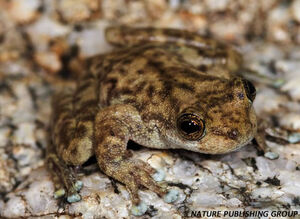
Rare frog cold case reopened
Monday October 7 2013
JCU reopens rare frog’s cold case
An environmental leap of faith has paid off for one of Australia’s rarest frogs, thanks to researchers at James Cook University in Cairns.
In early September, a team led by James Cook University doctors, Conrad Hoskin and Robert Puschendorf, performed the first successful frog translocation in Queensland’s history, giving the Armoured Mistfrog (Litoria lorica), pictured, a second chance at survival.
More than 20 years ago, the Armoured Mistfrog vanished from the rainforests of Far North Queensland. It was not seen again until 2008, rediscovered on the Carbine Tablelands of the Wet Tropics World Heritage Area.
The celebration was short-lived; intensive surveys over the following five years conducted by Drs Hoskin and Puschendorf turned up just one small population in a single rainforest stream.
“No species is safe, as a single population when disease or other threats could suddenly wipe out that population, and hence the entire species,” Dr Hoskin said.
With translocation the only option for the critically endangered frog, Dr Hoskin and Dr Puschendorf formed a team, including representatives from the Department of Environment and Heritage Protection, the Department of National Parks, Recreation, Sport and Racing, and the Western Yalanji Aboriginal Corporation.
“The potential gains from the translocation are very significant,” Dr Hoskin said.
“Moving these frogs might seem like a drastic action, and there are risks involved, but the threat to the species, if left as a single population, is too great.
“It is vital that we protect species from extinction and keep natural ecosystems in the Wet Tropics World Heritage Area intact.
“Having rediscovered this species, we don’t want to lose it a second time.”
On September 3 and 4 this year, 40 Armoured Mistfrogs - 20 males and 20 females - were carefully translocated to a new site about four kilometres upstream from the single known population. Seventeen of the translocated females carried eggs, which will hopefully be laid at the new site over coming months.
“The translocation was a great success with many of the released frogs visible the second night, sitting by a waterfall. I will visit the site again in about a month to see how they are settling in.” Dr Hoskin said.
Survival and breeding success will be monitored for both source and translocated populations over the next five years to ensure that the Armoured Mistfrog is on track and thriving.
“The Wet Tropics has many unique species and a tremendous diversity of life, and we need to keep it that way,” Dr Hoskin said.
The project was funded through the Australian Government’s National Environmental Research Program Tropical Ecosystems Hub.
